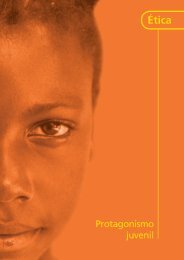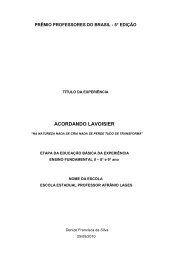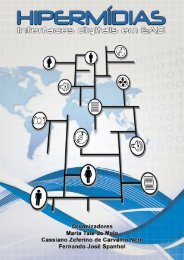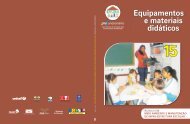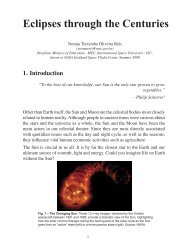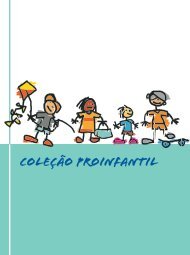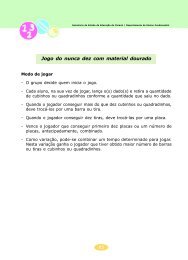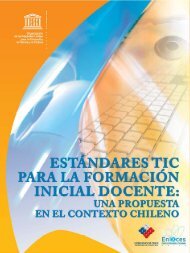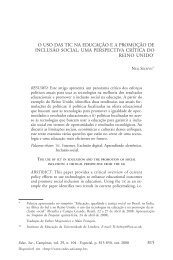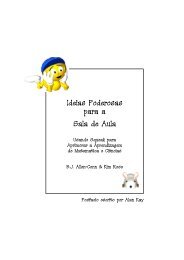BIO-CULTURAL COMMUNITY PROTOCOLS - Portal do Professor
BIO-CULTURAL COMMUNITY PROTOCOLS - Portal do Professor
BIO-CULTURAL COMMUNITY PROTOCOLS - Portal do Professor
Create successful ePaper yourself
Turn your PDF publications into a flip-book with our unique Google optimized e-Paper software.
APPENDIX RAIKA <strong>BIO</strong>-<strong>CULTURAL</strong> PROTOCOL<br />
APPENDIX II: OUR RIGHTS UNDER INTERNATIONAL LAW<br />
We the Raika in this Raika Biocultural Community Protocol<br />
identify the following principles and rights based on<br />
international law:<br />
Principle 1: The Raika are creators of breeds<br />
and custodians of their animal genetic<br />
resources for food and agriculture.<br />
Over the course of history, the Raika have managed and<br />
bred livestock, selected and used them, thus shaping them<br />
so they are well-adapted to our environment and<br />
its extremes. Keeping these breeds is a vital part of our culture<br />
and livelihoods. Yet these breeds and our livelihoods<br />
are under risk through loss of access to our traditional<br />
grazing lands. This has endangered our food security and<br />
our way of life. As recognised in the Global Plan of Action<br />
for Animal Genetic Resources and the Interlaken Declaration<br />
on Animal Genetic Resources, livestock keeping communities<br />
are thus the creators and custodians of the breeds that they<br />
maintain. We have therefore earned certain custodianship<br />
rights over these breeds, including the right to decide how<br />
others use the genetic resources embodied in our breeds.<br />
Principle 1 is supported by:<br />
Point 9 of the Interlaken Declaration on Animal Genetic<br />
Resources recognizes “that the genetic resources of animal<br />
species most critical to food security, sustainable livelihoods<br />
and human well-being are the result of both natural selection,<br />
and directed selection by smallholders, farmers, pastoralists<br />
and breeders, throughout the world, over generations”.<br />
Point 12 of the Interlaken Declaration on Animal Genetic<br />
Resources recognizes “the enormous contribution that the<br />
local and indigenous communities and farmers, pastoralists<br />
and animal breeders of all regions of the world have made,<br />
and will continue to make for the sustainable use,<br />
development and conservation of animal genetic resources<br />
for food and agriculture”.<br />
Part I Point 10 of the Global Plan of Action for Animal Genetic<br />
Resources: “all animal genetic resources for food and<br />
agriculture are the result of human intervention: they have<br />
been consciously selected and improved by pastoralists and<br />
farmers since the origins of agriculture, and have co-evolved<br />
with economies, cultures, knowledge systems and societies.<br />
Unlike most wild biodiversity, <strong>do</strong>mestic animal resources<br />
require continuous active human management, sensitive<br />
to their unique nature”.<br />
Principle 2: The Raika and the sustainable<br />
use of traditional breeds are dependent on<br />
the conservation of our ecosystem.<br />
Our traditional breeds are developed through the interaction<br />
between our livestock, the Raika pastoralists and our natural<br />
environment. This natural environment is conserved, inter<br />
alia, through traditional practices of the Raika, and traditional<br />
breeds lose their specific characteristics once removed from<br />
this ecosystem. The Raika therefore have a right to access<br />
our natural environment, so as to ensure the sustainable use<br />
and conservation of our breeds and the environment.<br />
Principle 2 is supported by:<br />
Article 8 of the Convention on Biological Diversity: “genetic<br />
resources should be conserved in the surroundings in<br />
which they have developed their distinct properties”.<br />
Article 10 (d) of the Convention on Biological Diversity<br />
demands that “local populations are supported to develop<br />
and implement remedial action in degraded areas where<br />
biological diversity has been reduce”.<br />
Chapter 15 (5) (g) of Agenda 21: requires States to<br />
“Take action where necessary for the conservation of<br />
biological diversity through the in situ conservation of<br />
ecosystems and natural habitats,… and the maintenance<br />
and recovery of viable populations of species in their<br />
natural surroundings.<br />
Principle 22 of the Rio Declaration: “Indigenous people and<br />
their communities and other local communities have a<br />
vital role in environmental management and development<br />
because of their knowledge and traditional practices.<br />
States should recognize and duly support their identity,<br />
culture and interests and enable their effective participation<br />
in the achievement of sustainable development”.<br />
85




